“We can literally see the smog in the air during recess… This freeway is constantly on our minds, and it is in our lungs, and it is a direct threat to the heart of the Tubman community.”
— Malina Yuen, 9th grader and Tubman graduate
Portland’s freeway fight spread its wings as it traded the confines of social media and online meeting testimony for a well-attended rally on Friday evening. Dozens of speakers and organizers joined with about 150 attendees at Harriet Tubman Middle School within earshot of the section of freeway the Oregon Department of Transportation wants to widen as part of their I-5 Rose Quarter project.
A trio of nonprofits launched a lawsuit against the project on Monday, citing ODOT’s failure to fully examine environmental impacts and lack of willingness to consider other, less-polluting design options. The rally was billed as a celebration of the lawsuit, and it certainly was; but it also felt like a coordinated indictment of capitalism, the destructive impacts of freeways, and the state agency that loves widening them.
The crowd was a diverse mix of ages, races, and styles. Toddlers doodled with chalk on the pavement at the school entrance, using it to embellish phrases like “Climate Leaders Don’t Widen Freeways” with rainbows and flowers.
Advertisement
Before a bevy of speakers riled up the crowd, volunteers with Sunrise PDX gathered hand-written postcards from attendees. The nonprofit No More Freeways, the lawsuit’s lead protagonist, had created the cards with custom messages to four key leaders: Oregon House Speaker Tina Kotek, Portland Commissioner Jo Ann Hardesty, Oregon Governor Kate Brown, and US DOT Secretary Pete Buttigieg.
With the pandemic still in effect, it was strange to attend an in-person event of this size. It was the largest gathering of transportation advocates for well over a year. Rally organizers took full advantage.

“I’m with an organization called No More Freeways and we just sued the federal government!” said lead rabble-rouser Aaron Brown triumphantly at the outset of the event.
A person named Tad, who was introduced by Brown as an “indigenous climate justice warrior” started off a slate of speeches with an impassioned plea against capitalism and a return to the values of his tribal ancestors. “Where is our climate justice? Where’s our transportation justice? I’ll tell you where: There is no justice on stolen land!”
The dire environmental impacts of the existing freeway and the potential of more damage from a wider one were a major theme.
Advertisement
Neighbors for Clean Air (NCA), another plaintiff in the lawsuit, explained that ODOT’s plans would bring freeway-using vehicles to within 30 feet of the school. “[Portland Public Schools] has been forced to spend $12 million [on a ventilation system] to reduce the health impacts of students and teachers,” said NCA’s Tori Heroux. “Children are most vulnerable to the long-term impacts from traffic because their lungs are still developing. And on average, children breathe about 50% more air per pound of bodyweight than adults do.”
What has helped spur a grassroots insurrection against this project isn’t simply a big, dirty freeway. It’s the intentional and racist choices made over generations by state and local officials to build highways through north Portland at the expense of historically black neighborhoods.
Joe Cortright, an economist and founding member of No More Freeways, told the crowd how a series of major highway projects starting in the 1950s decimated people’s homes and lives (he riffed off an article he recently published on City Observatory). “In 1950, 14,000 people lived in the Albina Neighborhood. In 1970, only 4,000 people lived here. This neighborhood was devastated by freeway construction and it’s ironic that ODOT is coming back and pretending that they’re offering restorative justice to the neighborhood by widening the freeway. Only a highway engineer would think you could fix the problem by making the freeway bigger.”
Symbolic of the diversity of opposition to this project, Cortright’s speech was followed by someone one-third his age. 21-year-old Sharona Shnayder is a Portlander and environmental activist who leads a global effort to pick trash.
“ODOT should be ashamed… for having the audacity to propose an action to expand this problem, to strangle these kids and their futures even further,” Shnayder said to rousing applause. “What’s frustrating about this situation is knowing that these children can’t even drive yet, yet they’re the ones who have to breathe the polluted air caused by all of those passing by just feet away from their classrooms… This is about a lack of morality. It’s about a lack of ethics. This is a lack of consciousness, knowing that we have a choice to do the right or the wrong thing, but are consistently choosing to do the latter.”
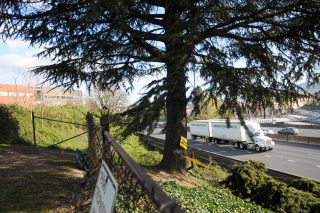
“There’s no room for compromise here. No freeway! No way! You’ll hear us! You’ll pay!”
Gerald Scrutchions knows how the freeway impacts the school because he teaches there. Wary of the impacts of unfiltered diesel engines, one day he counted how many passed by his classroom. It was 15 in one minute. “By a conservative estimate, I came up with about 10,000 diesel trucks passing a day,” Scrutchions said.
“We are in a school that claims to have the cleanest air quality in the city of Portland [due to a state-of-the-art ventilation system]. However, we seal the windows shut. Outside of the school is some of the worst air quality in the country.”
One of Scrutchions’ former students is Malina Yuen. Now a 9th-grader, she’s graduated from Tubman Middle School, but she’s one of the leaders in the fight to protect it from the freeway. Yuen knows about those dirty trucks all too well. “We can literally see the smog in the air during recess. On bad days kids with asthma were afraid to even come outside,” she shard. “This freeway is constantly on our minds, and it is in our lungs, and it is a direct threat to the heart of the Tubman community.”
Yuen’s friend and partner-in-activism is Adah Crandall. She was equally as forceful and effective in her words against ODOT. “It doesn’t take an expert to see that adding more lanes means more people driving, and more people driving means more pollution… Even the sixth graders at Tubman can understand this concept of induced demand; and for some reason, ODOT still cannot!”
If you missed the rally, check the full recording below (provided by No More Freeways):
— Jonathan Maus: (503) 706-8804, @jonathan_maus on Twitter and jonathan@bikeportland.org
— Get our headlines delivered to your inbox.
— Support this independent community media outlet with a one-time contribution or monthly subscription.





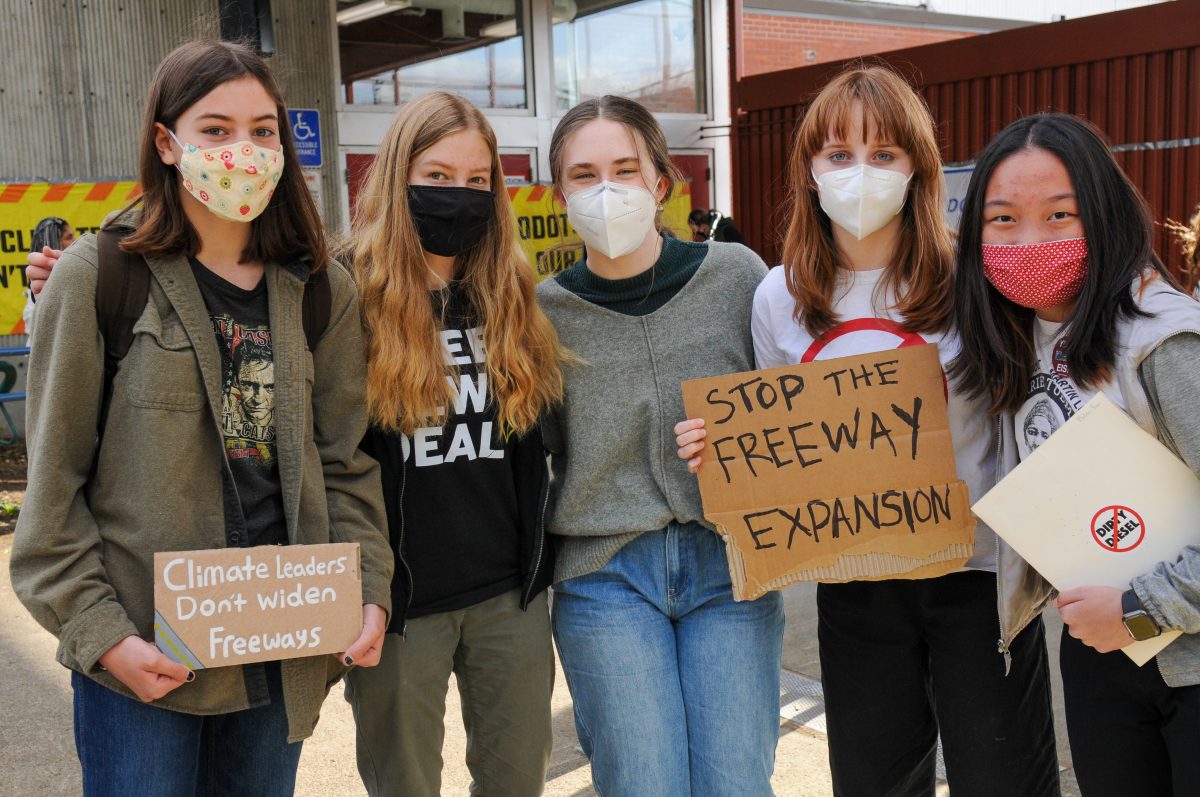
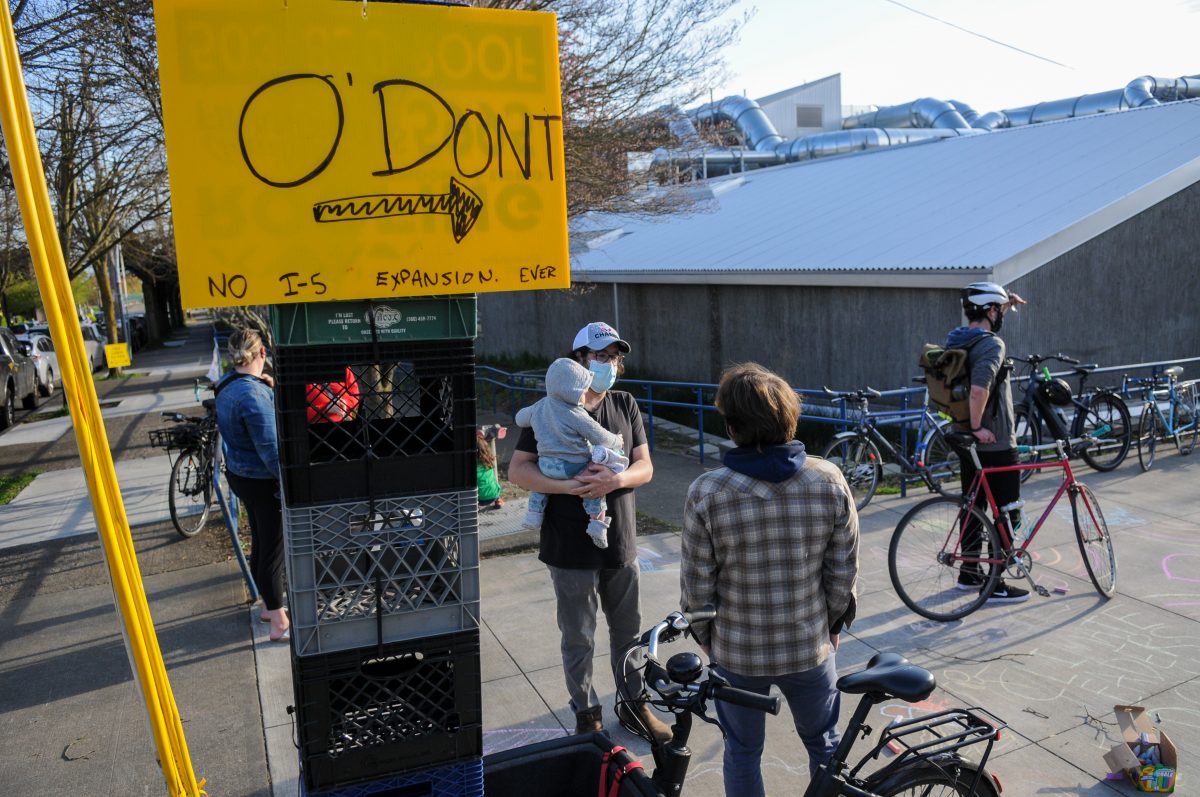


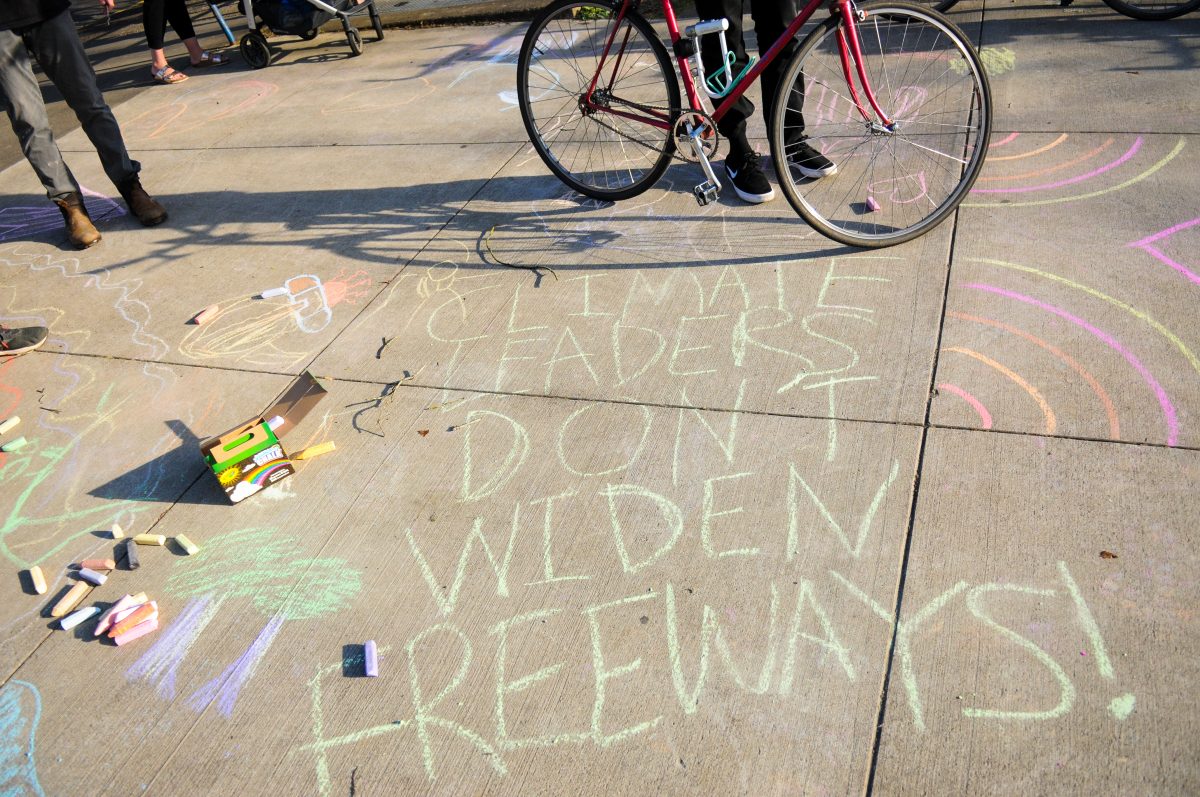





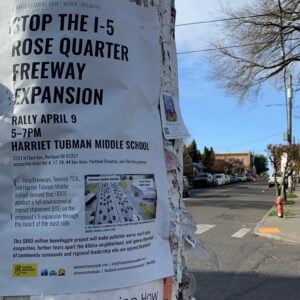

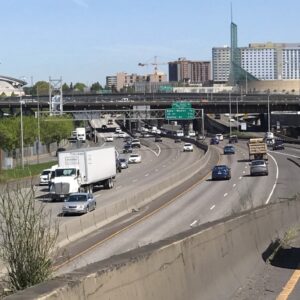
Thanks for reading.
BikePortland has served this community with independent community journalism since 2005. We rely on subscriptions from readers like you to survive. Your financial support is vital in keeping this valuable resource alive and well.
Please subscribe today to strengthen and expand our work.
“[Portland Public Schools] has been forced to spend $12 million [on a ventilation system] to reduce the health impacts of students and teachers,” said NCA’s Tori Heroux.
It was Portland Public Schools who reopened Tubman knowing full well about the air quality issues. The protestors can point all the fingers they want at ODOT but PPS should not get off Scot-free.
The assumption here is that any area with poor air quality should not allow a school. The problem with that idea is that highways and interstates affect a wide swathe of areas including but not limited to the higher income Lincoln HS to the lower income Kelly and Oliver Lent schools in E Portland. Are all of these schools then choosing to put their kids in harms way? Is it reasonable to simply accept the affects of emissions when other cities have made this problem virtually nonexistent by not having freeways pass through the city?
I agree. Once a freeway gets built, the land that is along the freeway but away from an interchange loses much of its value, as it gets all the noise and air pollution but loses all access to the highway. Naturally such cheap land then becomes a target for low-value uses such as schools, subsidized housing, low-rent woody walkups, low-status businesses, and public parks – in other words, places where we allow the poor to live.
On the other hand I agree with MOTRG that ODOT doesn’t deserve the level of blame they are getting. The decision of running a highway through a poor Slavic neighborhood (afterwards a poor Black neighborhood) and the ensuing land use decisions were made chiefly by the City of Portland. The highway was located next to schools, parks, and low-density ethnic residential neighborhoods partly because the land was so cheap (at that time, 1940s and 50s), but also because the local opposition on the part of nimby land owners was so relatively weak compared to other parts of town.
Was ODOT going to provide PPS with free land in a more optimal location? You are expecting too much from our cash-strapped school district. ODOT destroyed the value of this PPS parcel with they built I-5. They should have to pony up the money to relocate the school if this expansion moves forward.
The original school, Eliot Elementary, was there before I5. A few years ago, we parents in inner N and NE Portland worked together to open a middle school to serve our neighborhood because our kids were some of the only ones in all of PPS without a dedicated middle school. The K-8s in the neighborhood weren’t serving our kids; some of the middle schools were so small that the schools couldn’t offer robust programming. In a previous generation, Black and brown kids were bussed out of the neighborhood to access quality education. Parents of those kids protested to be able to provide a good education to kids in their own neighborhood.
I’m glad to be one of the parents who advocated for Tubman to re-open. We looked at other options, both for a dedicated school and alternatives. There were no other options to serve our kids. Our kids deserve a good education too.
One of the benefits of the I5 expansion that ODOT keeps pitching is a sound wall at Tubman. Why haven’t they already built this wall? They don’t care about these kids; they just want their highway.
PPS is not a rich district, and no one is providing the millions of dollars to site and build a new school for some of the city’s poorest kids. The middle school went where there was an appropriate facility. That doesn’t give ODOT license to make our air even worse.
And let’s not forget: ODOT has consistently lied about this project. First they said it was going to be the first freeway expansion to improve air quality. Now they say it’s about restorative justice.
ODOT only knows how to build highways. They are not capable of providing Oregon with the leadership we need to move forward with better infrastructure.
Comment of the week
I deeply regret my one vote for ODOT’s boss, Governor Kate Brown (for many reasons).
As with the Kindermoord movement in the Netherlands in the 70s, the Sunrise movement, and kids protesting in general are really hard to ignore for a lot of people in political positions. So proud of the kids at Tubman and the No More Freeways coalition.
Terrific video. I’m inspired by these young activists!
The funny thing about these protests is that ODOT did a very similar project on 205 between Sandy and Foster in the last two years and there wasn’t a peep from any of these people. Even though it goes through an area that is more diverse and low income than the part of I-5 they are looking to improve. I wonder why?
You have people who totally gentrified the neighborhood, now having the audacity to use the black community they displaced as their excuse to engage in their favorite hobby, protesting stuff. What a luxury it is to have the time and resources to oppose even the most basic infrastructure projects. It’s too bad they don’t take the time to talk to the everyday black folks that they pushed east of 205, because they would learn that those people don’t share their hatred of progress, and they have brutal commutes that would be improved by this project.
Exactly. This forum reeks of double standard.
Harriet Tubman is one of the only schools in all of Oregon where the student population is majority kids of color (this includes my kid, now in high school, who attended Tubman). There are still many Black and brown families in this neighborhood, and many send their kids to Tubman. No community is a monolith, but the Black and brown moms I know in inner N/NE are as opposed to this project as the white moms.
ODOT wants to paint freeway opponents as white gentrifiers because it serves their interest to pretend they are the real allies to the Black community. The Black-led Albina Vision Trust backed away from working with ODOT. You really want to argue that “everyday black folks” trust the racist highway department that tore down their parents’ houses?
And no one’s commute will be improved by this project. ODOT wants to build a highway so they are pretending this project will solve congestion, but it’s well known that freeway expansions never solve congestion. They make it worse.
“ODOT did a very similar project on 205 between Sandy and Foster.” Indeed ODoT did widen I205. The difference in the 205 project and the RQ is stark. The former was portrayed simply as a typical widening project. The latter was portrayed by ODoT as a safety project first, and then a restorative justice project after the safety benefits were found to be negligible to none (the area essentially has fender benders but virtually no deaths/injuries). ODoT also portrayed the project as a mere “auxiliary lane”, not widening, until after the FOIA request clearly showed multiple new lanes. Now ODoT is targeting restorative justice by potentially hiring a black-owned construction firm.
To your second point, regardless of who lives in N or E Portland, or of their perceived race, this project does not ultimately benefit anyone. Portraying the I5 expansion as “progress” and a “basic infrastructure project” ignores the overwhelming evidence that freeway widening leads to a brief period of time when traffic adjusts, and shortly thereafter, the same/worse amount of congestion. The analogy is fighting obesity by buying larger pants.
Induced demand can often be targeted with congestion pricing, which, as evidenced by the success it has in multiple cities around the world, does actually have a substantive and lasting effect on traffic patterns/congestion. Here is the example from Stockholm.
The real question here is: Are we smart enough to ignore political hyperbole, follow research, and solve this problem with evidence-based solutions, or do we simply ignore science and burn ~$800 million?
This project won’t improve commute times for people living east of I-205. Look at ODOT’s own projections before commenting.
ODOT answers to the state, not the local jurisdictions. What do our state leaders, starting with Gov Brown, say about this?
Let me be the voice of reason here, and say that Portland overwhelmingly wants to fix the congestion that plagues our freeways. “Induced Demand” doesn’t hold much water to me when our metro population is growing by leaps and bounds, get real. We’ll need more capacity regardless.
The air quality concerns are overblown anyway. All our air is unclean.
And I’m still not sure what ANY of this has to do with riding a bicycle.
You can ignore induced demand all you want, doesn’t make it less real. And if the population is growing so fast, then we’ll never keep up (we’re already behind, really) with it by mostly designing/building for SOV traffic. We need to focus on modes that transport people in a more space-efficient manner, like transit and yes, even bikes.
But the air quality concerns are overblown? Well, you are a voice, I’ll give you that…
You can’t build your way out of congestion. Yes, we all agree that congestion is bad. The difference is in the solution we want. ODOT says to build more roads to solve congestion, but it won’t work even if you put “induced demand” in quotes. No freeway project has ever alleviated congestion, because when you build more roads, more people use them. The only thing that has ever solved congestion: congestion pricing.
This has to do with riding a bicycle because the Flint Street overpass will be removed; because many of us live and bike through and near this highway and want to be able to breathe air that’s not filled with car emissions; and because BikePortland writes about transportation much more broadly.